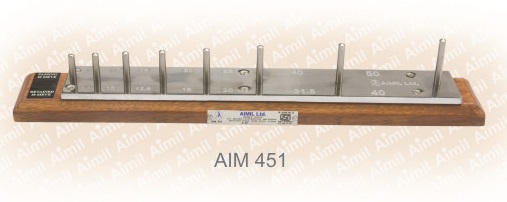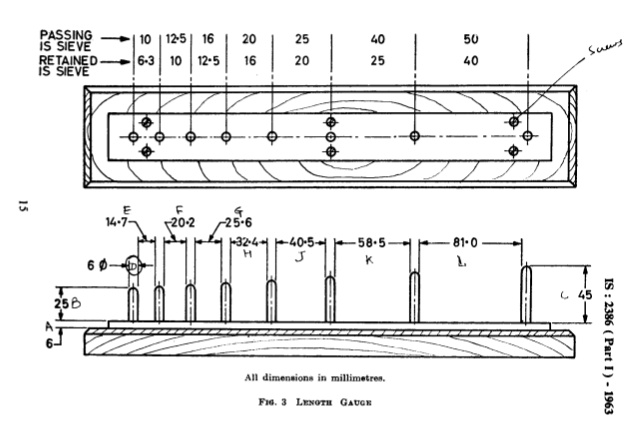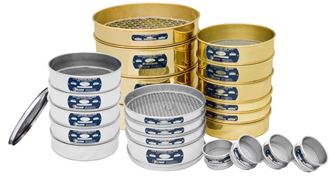AIM OF THE EXPERIMENT:
To determine the Flakiness Index of the given sample of course aggregate.
CODE OF REFERENCE:
• IS 2386(Part 1):1963 Methods of Test for Aggregates of Concrete- Particle Size and Shape. Reaffirmed Dec 2016
• ASTM 4791-10: Standard Test Method for Flat Particles, Elongated Particles or Flat Elongated Particles in Coarse Aggregates, American Society for Testing and Materials.
TEST DESCRIPTION
Elongation index test of an aggregate is the percentage by weight of particles whose greatest dimensions is greater than 1.8 times their mean dimensions. This test is also applicable to aggregates having size larger than 6.3 mm.
For calculating the elongation index of given sample of aggregates first the weight of each fraction of aggregate passing through and retaining on the specific set of sieves is noted down. Each of these pieces is then tried to pass through specified gauge length with its longest side and these elongated particles which do not pass through the specified gauge are separated. Then the elongation index is calculated as the total weight of material retained on various length gauges, expressed as a percentage of the total weight of sample gauged.
Elongation Index= [W2 / W1] x 100
Where W2= Weight of aggregates passing through 1.8 x dmean size
W1= Total weight of aggregates
For road constructions elongation index should be less than 15%.
RELEVANCE AND IMPORTANCE
For road construction especially in surface course the elongated shape of aggregates is not desirable. It is because they cause inherent weakness in road and there arises possibilities of breaking of these aggregates due to heavy loads imposed by vehicular traffic or at the time of compaction. So, to avoid the above-mentioned situation, the particles have to be tested for their elongation indices values to check their suitability for using in road constructions. This is the reason for the test being carried out.
Table 1: Limits of elongation index for different types of pavements (Source: MORTH)
| Sl No. | Type of pavement | Maximum limits of elongation index, % |
| 1 | Bituminous concrete | 25 |
| 2 | Water Bound Macadam | 15 |
APPARATUS REQUIRED:
- A weighing balance having an accuracy in measuring of 0.1% of the weight of sample.
- Metal Gauge as shown in figure below.
- IS Sieves of sizes 25 mm, 20 mm, 16 mm, 12.5 mm, 10 mm and 6.3 mm.

Fig 1: Elongation Index Metal Gauge
COURTESY: AIMIL LTD

Fig 2: Diagram of Elongation Index Gauge
COURTESY: SLIDESHARE

Fig 3: Set of IS Sieves
COURTESY: AIC- LAB EQUIPMENTS
PROCEDURE
1. The given sample of aggregates which are to be tested are passed through a set of sieves and they are separated into specified range of sizes.
2. A minimum of 200 pieces of any fraction are taken to be tested, and weighed properly by weighing balance.
3. From each of the range of size, the aggregates are then individually passed through the appropriate gauge of the length gauge with the longest side in order to separate the elongated particles.
4. The gauge length will be 1.8 times the mean size of the aggregate.
5. The portion of elongated aggregate which have length greater than the specified gauge from each range is weighed by weighing balance.
6. The weight which is obtained from above is then divided by the total weight of the sample taken from different size ranges and the ratio is expressed as percentage which is the required elongation index.
OBSERVATION TABLE
| Aggregates passing through IS Sieve (mm) | Aggregates retained on IS Sieve (mm) | Thickness of the gauge (1.8 times the mean size of the two sieve sizes) (mm) | Weight of the fraction (g) | Weight of the aggregate in each retained (g) |
| 25 | 20 | 40.5 | ||
| 20 | 16 | 32.4 | ||
| 16 | 12.5 | 25.6 | ||
| 12.5 | 10 | 20.2 | ||
| 10 | 6.3 | 14.7 | ||
| TOTAL | W= | w= | ||
CALCULATIONS
Total weight of the fraction, W=
Total weight retained fractions, w=
Therefore, Elongation Index = [w/W] x 100% =
PRECAUTIONS
- Safety shoes must be used along with masks and aprons at the time of test.
- Gauge should be cleaned thoroughly and dried before testing.
- Special care must be taken that no outer air enters when using the balance.
- All parts of equipment should be kept clean.
- After the end of test, sieve should be cleaned by smooth brush.
If you have a query, you can ask a question here.



Res/sir,
You put Flakines Index instead of Elongation Index in aim of the practical.
Thanks